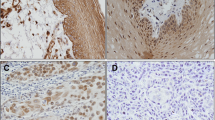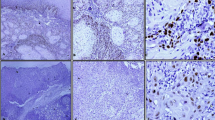Abstract
Squamous cell carcinoma of the oral cavity represents the sixth most common cancer worldwide and it is often preceded by pre-neoplastic lesions. Sometimes it is still difficult for pathologists to make objective differential diagnoses only on histological characteristics. Tumorigenesis is accompanied by altered expression of cell adhesion molecules, like carcinoembryonic antigen cell adhesion molecule (CEACAM)1. We wanted to investigative CEACAM1 in oral dysplastic lesions, carcinoma in situ (CIS) and oral squamous cell carcinoma (OSCC). We examined immunohistochemical CEACAM1 expression in 50 OSCC, 30 oral CIS and 40 pre-neoplastic lesions and assessed its correlation with clinical and pathological parameters. CEACAM1 was not expressed in normal mucosa, significantly expressed in CIS while it was negative in all the dysplastic lesions. In OSCC, high CEACAM1 expression was associated with tumor grade and inversely correlated with both overall and disease-specific 5-year survival. We showed that CEACAM1 expression is very dynamic: absent in dysplastic lesions, up-regulated in CIS and OSCC. We suggest that CEACAM1 could be a prognostic marker of OSCC and oral CIS. Our most important finding was that it could help pathologists diagnosing oral carcinoma in situ.




Similar content being viewed by others
References
Jemal A, Bray F, Center MM, Ferlay J, Ward E, Forman D (2011) Global cancer statistics. CA Cancer J Clin 61:69–90
Shah JP, Lydiatt W (1995) Treatment of cancer of the head and neck. CA Cancer J Clin 45:352–368
Hunter KD, Parkinson EK, Harrison PR (2005) Profiling early head and neck cancer. Nat Rev Cancer 5:127–135
Cavallaro U, Christofori G (2001) Cell adhesion in tumor invasion and metastasis: loss of the glue is not enough. Biochim Biophys Acta 1552:39–45
Thompson JA, Grunert F, Zimmermann W (1991) Carcinoembryonic gene family: molecular biology and clinical perspectives. J Clin Lab Anal 5:344–366
Scheffrahn I, Singer BB, Sigmundsson K, Lucka L, Obrink B (2005) Control of density-dependent, cell state-specific signal transduction by the cell adhesion molecule CEACAM1, and its influence on cell cycle regulation. Exp Cell Res 307:427–435
Sienel W, Dango S, Woelfle U, Morresi-Hauf A, Wagener C, Brümmer J, Mutschler W, Passlick B, Pantel K (2003) Elevated expression of carcinoembryonic antigen-related cell adhesion molecule 1 promotes progression of non-small cell lung cancer. Clin Cancer Res 9:2260–2266
Oliveira-Ferrer L, Tilki D, Ziegeler G, Hauschild J, Loges S, Irmak S, Kilic E, Huland H, Friedrich M, Ergün S (2004) Dual role of carcinoembryonic antigen-related cell adhesion molecule 1 in angiogenesis and invasion of human urinary bladder cancer. Cancer Res 64:8932–8938
Wang F, Guan B, Yang J, Wang H, Zhou C (2017) CEACAM1 is overexpressed in oral tumors and related to tumorigenesis. Med Mol Morphol 50:42–51
Barnes H, Eveson John W, Reichart P, Sidransky D (2005) WHO: pathology and genetics, head and neck tumours: tumours of the oral cavity and oropharynx. IARC Press, Lyon
Kuespert K, Pils S, Hauck CR (2006) CEACAMs: their role in physiology and pathophysiology. Curr Opin Cell Biol 18:565–571
Beauchemin N, Arabzadeh A (2013) Carcinoembryonic antigen-related cell adhesion molecules (CEACAMs) in cancer progression and metastasis. Cancer Metastasis Rev 32:643–671
Fiori V, Magnani M, Cianfriglia M (2012) The expression and modulation of CEACAM1 and tumor cell transformation. Ann Ist Super Sanità 48:161–171
Shinozuka K, Uzawa K, Fushimi K, Yamano Y, Shiiba M, Bukawa H, Yokoe H, Tanzawa H (2009) Downregulation of carcinoembryonic antigen-related cell adhesion molecule 1 in oral squamous cell carcinoma: correlation with tumor progression and poor prognosis. Oncology 76:387–397
Zhou CJ, Qu X, Yang YM, Wang FF, Dong ZQ, Wang CQ, Zhang XY, Liu GX, Wei FC, Sun SZ (2009) CEACAM1 distribution and its effects on angiogenesis and lymphangiogenesis in oral carcinoma. Oral Oncol 45:883–886
Wang N, Feng Y, Wang Q, Liu S, Xiang L, Sun M, Zhang X, Liu G, Qu X, Wei F (2014) Neutrophils infiltration in the tongue squamous cell carcinoma and its correlation with CEACAM1 expression on tumor cells. PLoS One 27:e89991
Bamberger AM, Kappes H, Methner C, Rieck G, Brümmer J, Wagener C, Löning T, Milde-Langosch K (2002) Expression of the adhesion molecule CEACAM1 (CD66a, BGP, C-CAM) in breast cancer is associated with the expression of the tumor-suppressor genes Rb, Rb2, and p27. Virchows Arch 440:139–144
Nittka S, Günther J, Ebisch C, Erbersdobler A, Neumaier M (2004) The human tumor suppressor CEACAM1 modulates apoptosis and is implicated in early colorectal tumorigenesis. Oncogene 23:9306–9313
Albarran-Somoza B, Franco-Topete R, Delgado-Rizo V, Cerda-Camacho F, Acosta-Jimenez L, Lopez-Botet M, Daneri-Navarro A (2006) CEACAM1 in cervical cancer and precursor lesions: association with human papillomavirus infection. J Histochem Cytochem 54:1393–1399
Busch C, Hanssen TA, Wagener C, Obrink B (2002) Down-regulation of CEACAM1 in human prostate cancer: correlation with loss of cell polarity, increased proliferation rate, and Gleason grade 3 to 4 transition. Human Pathol 33:290–298
Cruz PV, Wakai T, Shirai Y, Yokoyama N, Hatakeyama K (2005) Loss of carcinoembryonic antigen-related cell adhesion molecule 1 expression is an adverse prognostic factor in hepatocellular carcinoma. Cancer 104:354–360
Gale N, Zidar N, Poljak M, Cardesa A (2014) Current views and perspectives on classification of squamous intraepithelial lesions of the head and neck. Head Neck Pathol 8:16–23
Zhang HK, Liu HG (2012) Is severe dysplasia the same lesion as carcinoma in situ? 10-Year follow-up of laryngeal precancerous lesions. Acta Otolaryngol 132:325–328
Toshiyuki I (2011) Oral premalignant lesions: from the pathological viewpoint. Int J Clin Oncol 6:15–26
Kobayashi T, Maruyama S, Cheng J, Ida-Yonemochi H, Yagi M, Takagi R, Saku T (2010) Histopathological varieties of oral carcinoma in situ: diagnosis aided by immunohistochemistry dealing with the second basal cell layer as the proliferating center of oral mucosal epithelia. Pathol Int 60:156–166
Mikami T, Cheng J, Maruyama S, Kobayashi T, Funayama A, Yamazaki M, Adeola HA, Wu L, Shingaki S, Saito C, Saku T (2011) Emergence of keratin 17 vs. loss of keratin 13: their reciprocal immunohistochemical profiles in oral carcinoma in situ. Oral Oncol 47:497–503
Funayama A, Cheng J, Maruyama S, Yamazaki M, Kobayashi T, Syafriadi M, Kundu S, Shingaki S, Saito C, Saku T (2011) Enhanced expressions of podoplanin in oral carcinomas in situ and squamous cell carcinomas. Pathobiology 78:171–180
Nozawa H, Chiu C, Hanahan D (2006) Infiltrating neutrophils mediate the initial angiogenic switch in a mouse model of multistage carcinogenesis. Proc Natl Acad Sci USA 103:12493–12498
Coussens LM, Werb Z (2002) Inflammation and cancer. Nature 420:860–867
Chen Z, Chen L, Baker K, Olszak T, Zeissig S, Huang YH, Kuo TT, Mandelboim O, Beauchemin N, Lanier LL (2011) CEACAM1 dampens antitumor immunity by down-regulating NKG2D ligand expression on tumor cells. J Exp Med 208:2633–2640
Gebauer F, Wicklein D, Horst J, Sundermann P, Maar H, Streichert T, Tachezy M, Izbicki JR, Bockhorn M, Schumacher U (2014) Carcinoembryonic antigen-related cell adhesion molecules (CEACAM) 1, 5 and 6 as biomarkers in pancreatic cancer. PLoS One 19:e113023
Author information
Authors and Affiliations
Corresponding author
Ethics declarations
Conflict of interest
The authors declared no conflict of interest.
Rights and permissions
About this article
Cite this article
Simonetti, O., Lucarini, G., Rubini, C. et al. Correlation between immunohistochemical staining of CEACAM1 and clinicopathological findings in oral pre-neoplastic lesions and squamous cell carcinoma. Med Mol Morphol 51, 41–47 (2018). https://doi.org/10.1007/s00795-017-0169-4
Received:
Accepted:
Published:
Issue Date:
DOI: https://doi.org/10.1007/s00795-017-0169-4




